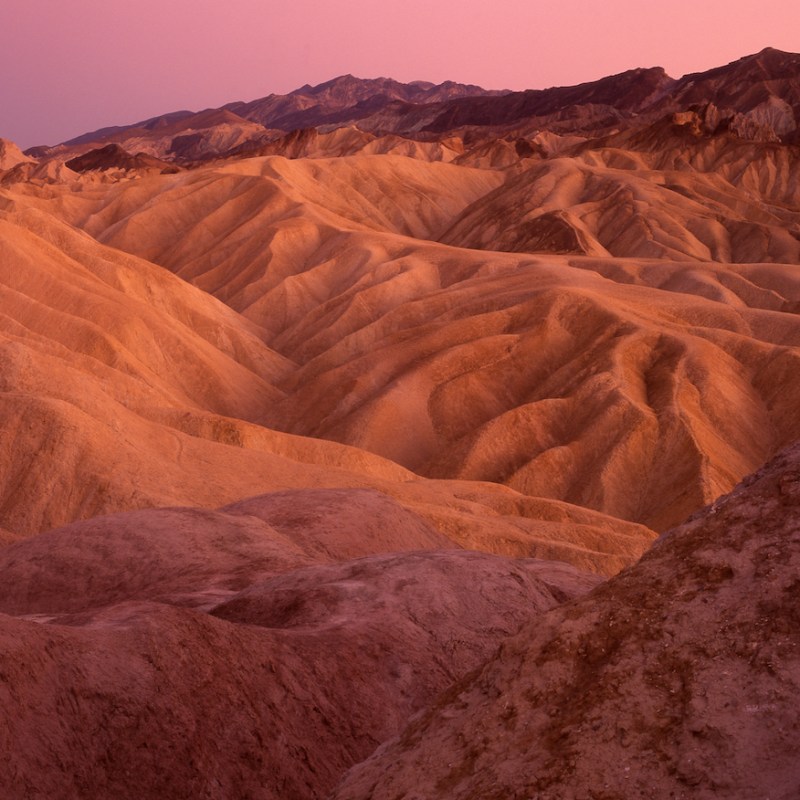
Virtually everything about Death Valley is extreme. From the furnace-like heat to the super-low elevation to the scary-sounding name, the eastern California national park is sure to take your breath away.
Videos by TravelAwaits
At a whopping 3 million acres, Death Valley National Park is the fifth-largest national park in the United States (behind four Alaskan parks). Packed into the park known to be the nation’s hottest, lowest, and driest are valleys, deserts, sand dunes, salt flats, and rugged mountain ridges.
A wonderful byproduct of all of those extremes: countless big and bold views. The best way to experience the park is by venturing onto the numerous trails and viewpoints that are spread throughout Death Valley.
After a drive-through visit several years ago, I returned recently to take a closer look. The trip confirmed my first impression – that Death Valley is a true natural treasure and a one-of-a-kind destination.

When To Go
It should probably go without saying that summer is not the time to visit Death Valley. When I visited in late April, temperatures at the Furnace Creek Visitor Center were already climbing above 110 degrees F. And by June 2021, the park was posting temperatures above 120.
It’s best to plan ahead for a visit in the late fall, winter, or early spring, when the average highs are in the 60s, 70s, and 80s. November, with an average high of 77 degrees, and March, with an average high of 82, are optimal.
Based on my recent visits, as well as recommendations from the national park and state tourism websites, here are 9 of the best spots to take in the big views in Death Valley National Park.

1. Badwater Salt Flat
In my view, Badwater is the quintessential not-to-be-missed spot in Death Valley. At 282 below sea level, it is a genuine phenomenon, stretching for about 5 miles from ridgeline to ridgeline.
Although you could take in the view from the parking lot that overlooks the flat, I recommend walking at least a mile or so along the hard-packed sand trail. As you get farther out, the salt flat’s ridges become more defined, and you get an increasing feeling of being in another world.
Walking to the edge of the salt flat and back is 1 mile and will take about half an hour. Walking to the other side of the flat is 5 miles each way (10 miles total) and could take about half a day. Most people I encountered were doing something in-between, turning back after a mile or two.
On the way back to the parking lot, be sure to look closely at the rugged mountains in front of you. Off a bit to the left and about halfway up, you’ll see a sea level sign posted on the mountain wall. It lends some real-time perspective to just where you are.
Pro Tip: It is best to get to Badwater as early as possible in the morning. Depending on the season, the high temperatures can make walking on the salt flat difficult despite the flat terrain. When I visited mid-afternoon in April, the heat emanating from the white sand was overpowering. I decided to return early the next day, and the cooler morning temperatures allowed for a pleasant walk out onto the salt flat.

2. Mesquite Flat Sand Dunes
Another iconic view of Death Valley is available at the Mesquite Flat Sand Dunes – the most famous and accessible of the national park’s numerous dune sites.
Located in the Stovepipe Wells Village area, the dunes feature seemingly endless mounds of sand backed by rugged mountains. The scene is set off beautifully by twisted old mesquite trees.
Reaching the summit of the high dune requires an easy-to-moderate 1-mile hike each way, and will take about an hour. There is no formal trail, so hikers should be prepared to trek through shifting sand.
Pro Tip: For lovers of sand dunes, the Mesquite Flat Sand Dunes site is one of 7 Must-Visit Sand Dunes Of The Southwest.

3. Natural Bridge Canyon
I can never pass up a natural rock arch, so I was excited to check out the Natural Bridge hike located along a short unpaved road east of Badwater Road. The bridge didn’t disappoint – rising dramatically about 35 feet above the desert floor and backed by the vibrantly blue California sky.
The trip to the bridge is about a third of a mile long, is rated as easy, and will take about 45 minutes round-trip.
Pro Tip: Despite the short distance, be sure to carry plenty of water on the Natural Bridge hike. On the 106-degree day that I hiked it, the 0.3-mile, mostly shade-less, uphill walk began to feel more like 3.0 miles.

4. Dante’s Ridge
For an opportunity to feel like you’re walking on the top of the world, consider the 4-mile hike (8 miles round-trip) along Dante’s Ridge to Mt. Perry.
The park’s website rates the hike as strenuous, with about 1,200 feet of combined elevation gain. It adds that the route is not an official trail, and the entire round-trip hike could take 4 to 6 hours. Still, experienced and fit hikers regularly make the trek along the ridgeline that offers wide-open views all along the way.

The hike begins at Dante’s View, a popular viewpoint that features sweeping views of the mountains in the distance and the salt flats below.
Pro Tip: Even if you don’t plan to hike Dante’s Ridge, be sure to make the 13-mile detour drive to Dante’s View, considered one of the most photogenic spots in the park for its incomparable views of the massive valley spread below.

5. Ubehebe Crater Loop
It’s not for everyone because of its exposed edges, but the Ubehebe Crater Loop offers a close-up view of the colorful hole in the ground that was formed when molten lava came in contact with groundwater, causing steam pressure to build in a massive volcanic event. “When the dust settled, a half-mile-wide, 600-foot-deep crater remained,” according to Visit California.
The park’s website rates the 1.5-mile loop as moderate, but it cautions that the hike features exposed edges and should be avoided by anyone with a fear of heights. The round-trip hike is estimated to take about an hour. It has about 500 feet of elevation gain.
Pro Tip: The hike is usually done counterclockwise, which puts the uphill section at the beginning. Within about a half-mile, the nearby Little Hebe Crater comes into view – a spot where hikers looking for a shorter trip typically turn back.

6. Zabriskie Point
Not only does Zabriskie Point feature one of the Death Valley’s most stunning viewpoints, but it is also an entry point for two of the park’s scenic trails.
Located near the Highway 190 entrance to the park, Zabriskie Point can be accessed via a short, but somewhat steep, paved 100-yard trail from the parking lot. From virtually anywhere at the top of the point, a colorful, panoramic vista is visible below. A series of interpretive signs tell the history of the region’s geology, as well as the more recent history of borax mining.
The signs also explain the range of hiking options available from the point, including the moderate-to-strenuous loop consisting of the 2.5-mile round-trip Badlands Loop and the 2.5-mile one-way Golden Canyon trail (also accessible from Badwater Road). Depending on the route, the hike will take 1.5 to 4.5 hours.
Pro Tip: Zabriskie Point is a popular spot for watching the sunrise and sunset.

7. Darwin Falls
It seems hard to believe in the midst of one of the driest places on earth, but Death Valley features its very own waterfall. Darwin Falls is described as a year-round, spring-fed waterfall located west of Panamint Springs.
The 2-mile out-and-back round-trip hike is rated as moderate, and the route is unmarked. Those who make the trek are treated to the beautiful sight of rushing water in the desert, surrounded by an oasis of trees, cattails, and ferns.
Pro Tip: It is important to remember, however, that hikers who make the trek to Darwin Falls are not allowed to swim in the pool at its base. “Please do not enter the pool, as it is the drinking source for nearby Panamint Springs Resort,” says the National Park Service website.

8. Artists Drive
While Artists Drive is more a scenic drive than a hike, it offers a number of spots for pulling over and walking a short distance to get to massive views.
In fact, the park rates the nine-mile one-way drive as one of the three top must-see spots in Death Valley.
Pro Tip: I recommend pulling over onto as many of the drive’s viewpoints as you have time for. And once you’re stopped, be sure to check out any available viewpoint trails, especially the one at the stunning Artists Palette, where parts of 1977’s Star Wars Episode IV: A New Hope were filmed.

9. Ashford Mill Ruins
Although not really a hike, the ruins at Ashford Mill offer a fascinating glimpse into the region’s mining history, along with sweeping views of the desolate terrain.
A sign at the ruins notes that in 1914, gold ore from the Golden Treasure Mine, 5 miles to the east, was processed at the mill for shipment to a smelter. The remote ruins, located in the far southeastern corner of the park, make a great place to stretch your legs and get a feel for the lives of the early miners.

Pro Tips
The parking lots at many of the popular stops in Death Valley feature vault-toilet restrooms. Still, some, like Ubehebe Crater, Dante’s View, and Darwin Falls, do not, so it pays to check ahead on the Death Valley website to get information on the amenities at the various trailheads.
Death Valley is a two-hour drive from Las Vegas, making it a convenient day trip or weekend getaway destination from Nevada’s largest city. Planning a trip to the area? More information is available at Visiting Death Valley National Park: What To Know Before You Go.
